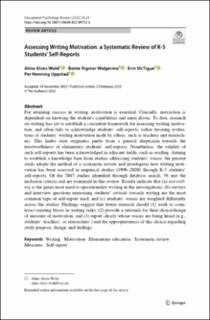| dc.contributor.author | Alves-Wold, Aline | |
| dc.contributor.author | Walgermo, Bente R. | |
| dc.contributor.author | McTigue, Erin | |
| dc.contributor.author | Uppstad, Per Henning | |
| dc.date.accessioned | 2023-05-03T07:22:48Z | |
| dc.date.available | 2023-05-03T07:22:48Z | |
| dc.date.created | 2023-03-31T16:04:36Z | |
| dc.date.issued | 2023 | |
| dc.identifier.citation | Alves-Wold, A., Walgermo, B. R., McTigue, E., & Uppstad, P. H. (2023). Assessing Writing Motivation: a Systematic Review of K-5 Students' Self-Reports. Educational Psychology Review, 35(1), 24. | en_US |
| dc.identifier.issn | 1040-726X | |
| dc.identifier.uri | https://hdl.handle.net/11250/3065899 | |
| dc.description.abstract | For attaining success in writing, motivation is essential. Crucially, instruction is dependent on knowing the student’s capabilities and inner drives. To date, research on writing has yet to establish a consistent framework for assessing writing motivation, and often fails to acknowledge students’ self-reports, rather favoring evaluations of students’ writing motivation made by others, such as teachers and researchers. This limbo state originates partly from a general skepticism towards the trustworthiness of elementary students’ self-reports. Nonetheless, the validity of such self-reports has been acknowledged in adjacent fields, such as reading. Aiming to establish a knowledge base from studies addressing students’ voices, the present study adopts the method of a systematic review and investigates how writing motivation has been assessed in empirical studies (1996–2020) through K-5 students’ self-reports. Of the 7047 studies identified through database search, 56 met the inclusion criteria and are examined in this review. Results indicate that (a) storytelling is the genre most used to operationalize writing in the investigations, (b) surveys and interview questions measuring students’ attitude towards writing are the most common type of self-report used, and (c) students’ voices are weighted differently across the studies. Findings suggest that future research should (1) work to counteract existing biases in writing tasks, (2) provide a rationale for their choice/design of measure of motivation, and (3) report clearly whose voices are being heard (e.g., students’, teachers’, or researchers’) and the appropriateness of this choice regarding study purpose, design, and findings. | en_US |
| dc.language.iso | eng | en_US |
| dc.publisher | Springer | en_US |
| dc.rights | Navngivelse 4.0 Internasjonal | * |
| dc.rights.uri | http://creativecommons.org/licenses/by/4.0/deed.no | * |
| dc.title | Assessing Writing Motivation: a Systematic Review of K-5 Students' Self-Reports | en_US |
| dc.type | Peer reviewed | en_US |
| dc.type | Journal article | en_US |
| dc.description.version | publishedVersion | en_US |
| dc.rights.holder | The authors | en_US |
| dc.subject.nsi | VDP::Samfunnsvitenskap: 200::Pedagogiske fag: 280 | en_US |
| dc.source.volume | 35 | en_US |
| dc.source.journal | Educational Psychology Review | en_US |
| dc.identifier.doi | 10.1007/s10648-023-09732-6 | |
| dc.identifier.cristin | 2138975 | |
| cristin.ispublished | true | |
| cristin.fulltext | original | |
| cristin.qualitycode | 1 | |

